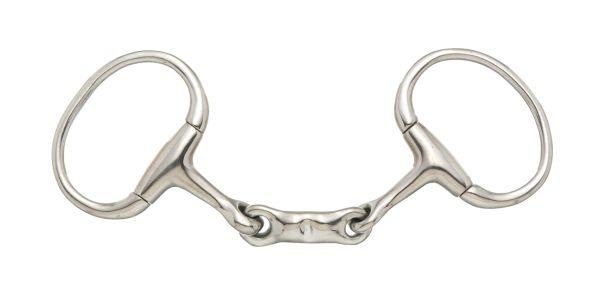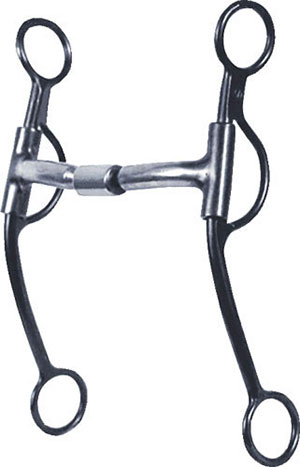A bit post? Yet again? Okay, to be very honest, I was supposed to be writing two more posts, Meet Diesal(It’s an introduction to Diesal with a funny twist to it, as the previous intro was very short.) and Backyard Breeding(it’s all about backyard breeding, and I just gave a sneak peak to them both) but I conveniently got the writers block and forgot what I wanted to mention. And I got this quick idea so I decided to write about it. I will be writing the other two as soon as I can remember.
To begin with, I’d like to clear a confusion between snaffles and curbs. Some people think that a snaffle is a bit with a jointed mouthpiece. Well, that’s nowhere near the case. A snaffle can have a single mouth, a jointed mouth or a double-jointed mouth. Maybe we must cover the anatomy of a bit first?

The bit in the above picture is a snaffle bit. The reins and the cheekpiece both attach to the bit rings. The snaffle is any bit with no leverage, no matter the mouth.

A curb is any bit with leverage. Think about what will happen when you pull on the reins with the above bit.(You must imagine the reins to be in the curb ring, not the snaffle one.) As you pull them, wouldn’t the bit bend upwards in the horses’ mouth and pull down on the cheekpiece? Obviously. That’s what the curb does. The length of the shanks and whether they’re swept backward(like the above bit) or not all affects where and how the bit applies pressure, but since I’m not very sure about what does what myself I won’t mention anything about that for now. If you’re unfamiliar with the curb strap/chain, it’s a strap or chain that goes from the above ring to the other one, so when the reins are pulled, it twists and applies pressure to the sensitive area just behind the horses’ chin. It’s commonly used with most curbs and it’s purpose is to gain better control when slowing a horse.
So, a snaffle is a bit with ZERO leverage and any sort of bit that has leverage is a curb. The gag bit is also a curb, even though it doesn’t have any shanks. The reason it’s a curb is because when the gag reins are pulled, the bit twists onto the tongue and then moves up in the horses’ mouth because the reins go through holes in the middle of the ring and join to the crownpiece of the bridle.
Okay, so I’ve (hopefully) cleared any confusion (if any) about snaffle bits. So now we’re going to move on about which bit to use. Many people say that the curb is a ‘nasty’ bit and the snaffle is a ‘good’ bit; however, that is not true.
The bit is equipment, and therefore, like all equipment, one cannot say it is good or bad. It is in the hands of the user whether he chooses to make that equipment good or bad.
You’ve probably heard that piece of text from me in previous posts as well and I sometimes even say that on social media when there is a fight on harsh bits. I agree, sometimes, the way a specific bit is built or its mechanism can be painful to the horse regardless of the rider’s hands, but you can’t judge the majority of bits just because it looks cruel. Under good hands, the worst of worst curbs can be very good.
I read this on some site:
What is the entire difference between a curb and a snaffle? One has leverage and the other, not. In harshness, a light rein can transform the curb into the gentlest bit and a harsh one can make the very snaffle titled ‘The horses’ mouths’ best friend’ into ‘the horse’s mouth’s worst nightmare’.
I like that saying because, all in all, it is very true. It all boils down to how one uses the piece of equipment. A gun, for example, is an item otherwise used for general self-defense or for sports. Anything harmful with that? No. But one can use that very gun that he claims is for self-defence to kill an innocent human. Is that not true? Obviously, it is up to the hand behind the trigger to decide what he uses the item for; good or bad. Because it has the ability to be used for bad reasons, does that make a gun bad? At least, I don’t think so. The same goes for bits. Think about the curb bit as a gun; most of them have a bad reputation for being ABLE to do harm. But with a good hand, it’s just like a gun being used for self-defense! No harm caused! Now think of a snaffle as a gun; most of them have a good reputation so imagine them as a small pistol used for sports. Can one not shoot someone with that too? Obviously, they can. Once again, if you’ve got a good hand, then it’s a normal sports gun, but with a hard hand, that very same ‘sports gun'(snaffle bit) can be used to ‘murder'(be bad to the horse’s mouth).
Here you go. A curb is not a bad bit and snaffle is not a good bit. So now, what bit should you use? It all depends on what you need and what you horse needs. Try being gentler to their mouth. Now, that is a lot easier to say than to do. I will not go in detail into bitting. Bitting is best left to someone who knows the horse, the mechanics of the bit, who will ride and how, everything. In basic terms, an expert. Not top-of-the-class rider, horseman, champion, three times gold medalist, blah-blah, not that stuff. Just someone who knows that job. But you, as a user, should know everything ’bout that bit and why you’re choosing it. A person like me cannot sit miles away from you and your horse and tell you to use that bit and not this. Even, depending on the horses behaviour, choosing between a loose ring snaffle and and eggbut cannot be decided from over the web with no details. So if you are looking for a good bit, I’d say do some research on possible options that you think from a brief description would suit your horse, ask others, and then try different bits. Just do what you think. I’ll leave it of here.
I don’t know whether the examples chosen are good ones :\
But atleast I posted, and now until my writers’ block is over, just wait patiently for my next two posts.
P.S. I might be shifting my stories over to my blog. Stay tuned! 🙂
Note from future self: For once, past self had a vaguely good opinion